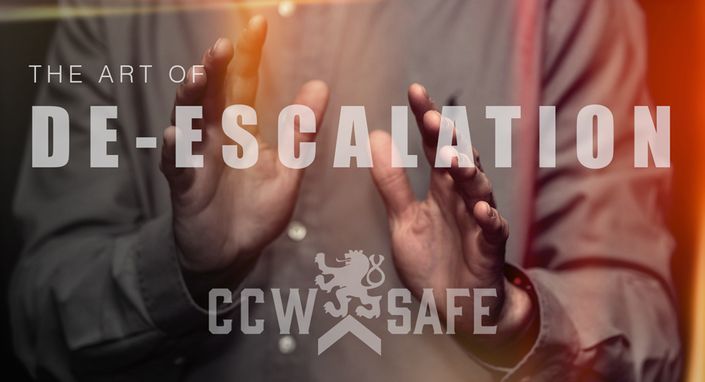

In 1991, police departments across the United States began to enter into a new era of policing after the arrest of Rodney King, Jr. in Los Angeles. I remember this, because I started the police academy in June of that year. That incident, followed by others like it across the nation, brought forth a new term to law enforcement known as De Escalation. Verbal Judo was the first wave of training and thought process on de escalating potentially violent encounters, but by 2000 or soon after, it simply became the term of de-escalation.
On the civilian side of the house, a little over a decade later, the trial of George Zimmerman in the Trayvon Martin shooting introduced the term de-escalation to the public, specifically to concealed carry permit holders, and it was no longer a term locked to law enforcement.
Since then, we have seen a number of cases where de-escalation, if applied, would have possibly saved one life, while keeping another from being sentenced to a life in prison. We’ve talked about the Kaarma and Smith case recently on our blog, and will be covering others such as the Wafer case and the Gasser case in the upcoming months.
In this course, we are going to talk about de-escalation, what it is, and some of the techniques that are taught to law enforcement to be used in potentially violent encounters, and we are going to show you how those techniques can be used if you are a concealed carrier, or if you carry in self defense. This course includes over 20 minutes of video content.
Upon completion of this course, you will be able to print a certificate of completion.
Your Instructor

Stan Campbell has over 20 years of experience as a police officer in Oklahoma City. He retired as a Lieutenant over a street crime team, and spent over 10 years on the Tactical Unit (SWAT) and has spent 15 years developing and teaching self-defense curriculum. Stan is a certified National self-defense Instructor and has also instructed officers in British Territories. Stan has extensive experience and knowledge in the critical incident command system, officer involved shootings and use of force incidents.
Training History and LE Education
• Developing the Leader in You for Law Enforcement (by The American Institute for Servant Leadership), Use of Deadly Force In-Service, Advanced Sniper School, Oklahoma Bureau of Narcotics - Indoor Marijuana Investigator, Buccal Swab Collection, Weapons of Mass Destruction Awareness/NIMS Course, U.S. Department of Justice- Site Assessment and Site Vulnerability School, Communication/Cultural Context Course, Hostage Rescue Course (by National Tactical Officer Association), OSBI – Sub Machine Gun Operators School, Less Lethal-Kinetic Impact Weapon Course, Supervisor’s Bean Bag Shotgun Course, Taser International’s Taser Instructor School, Tactical Officer’s School (OCPD), U.S. Department of Justice - Hick’s Advanced Arrest & Control, U.S. Department of Justice - Hick’s Basic Arrest & Control, Oklahoma State University - Supervision of Police Personnel Course, The Investigative Interview School (OCPD), Search Warrant Execution School (C.L.E.E.T.), Oklahoma Bureau of Narcotics – Basic Narcotic and Drug School, Monadnock Expandable Baton Instructor School (C.L.E.E.T.), National Law Enforcement (N.l.E.) Training Center – Basic & Advanced Grappling Instructor, N.L.E. Training Center – Basic & Advanced Handcuffing Instructor School, N.L.E. Training Center – Basic & Advanced Handgun/ Long gun Retention Course, N.L.E. Training Center – Basic & Advanced Control/ Defensive Tactics Instructor, Advanced Instructor Development (C.L.E.E.T.), Oklahoma Bureau of Narcotics – Narcotic Investigator School, N.L.E. Training Center – Control/Defensive Tactics Instructor School, Basic Search Warrant Execution School (C.L.E.E.T.), Homicide Investigator School (C.L.E.E.T.), Bomb and Booby Trap Detection School (C.L.E.E.T.), Field Training Officer’s School (OCPD), Basic Instructor Development School (C.L.E.E.T.), Custody and Control Instructor School (C.L.E.E.T.), and Expandable Baton/ O.C. Gas School.
Career Accomplishments
• A Medal of Valor for response to OKC Federal Building Bombing (1995) first four officers to respond to location, A Letter of Commendation for assisting approx. 40 victims and personally carrying 5 victims out of destroyed OKC Federal Building following bombing, Developed Revised OCPD Defensive Tactics Program, Created OCPD Threat Assessment/Critical Inc. Form, Developed “Anatomy of a Drug Raid” class, Developed Revised “Shooting Officer Down Response Drill” and Revised “IMPACT Car Assault/Recovery Drill”, 26 certificates, and many letters of appreciation from various schools and organizations.
Instruction and Teaching Experience
Instructed over 500 OCPD recruit officers in the Control Defensive Tactics course (Academy classes #112 through #128), Instructed over 800 OCPD officers (every other year) in the area of Control Defensive Tactics in-service updates, Instructed (1997-2004) Cultural Diversity Course to over 300 OCPD recruit officers, Instructed (1997-1999) Defensive Tactics to over 100 OKC Juvenile Detention Center employees, Instructed (2003) 50 Reno Nevada Sheriffs Department in the “Hicks – Police Arrest and Control Program”, Instructed (2004) 200 Houston Texas Police officers in the “Hicks – Police Arrest and Control Program”, Instructed (2004) over 200 OCPD officers in “Police Ethics’ in-service, Instructed (2005) over 2,500 Baltimore Maryland Police officers in the “Hicks – Police Arrest and Control Program”, Instructor (2009) over 25 employees of Island of Bermuda Police department in the C.O.R.E. Inc. Defensive Tactics Program, Instructed (2010) over 50 OCPD IMPACT officers in Shooting Officer Down Drill, Walk and Shoot Drills, Partner Shooting Drills, Live Shoot House Raid Training, Instructed (2011) over 50 OCPD IMPACT officers in “Anatomy of a Drug Raid” school and Instructed (2012) over 50 OCPD IMPACT officers in Car Assault Recovery and Drug Raid Training.
